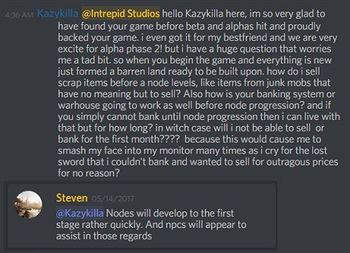User talk:Shadon Sol
اذهب إلى التنقل
اذهب إلى البحث
https://ashesofcreation.wiki/index.php?title=Template:Node_advancement/de&action=edit --
Alle Aktivitäten (هلئسا, عمج, تاراغلا, etc.) von Bürgern sowie allen anderen Spielern innerhalb des Einflussbereichs einer Node tragen zum Wachstum (Fortschritt) dieser speziellen Node bei.[1][2]
Durch das Wachstum einer Node werden einerseits deren einzigartigen Inhalte freigeschaltet, andererseits wird der Fortschritt der umliegenden Nodes auf die nächste Stufe blockiert.[3]
- Nodes steigen schnell auf die erste Stufe auf. Dadurch entstehen die ersten NPC-Dienstleistungen, beispielsweise der Verkauf oder die Aufbewahrung von items.[4]
- Je fortgeschritttener die Node ist, desto größer ist ihr ZOI.[5]
- Weniger weit fortgeschrittene Nodes (auch Vassal nodes genannt), welche im Einflussbereich einer höherstufigen Node liegen, können weiterhin Erfahrung sammeln, jedoch müssen sie stets mindestens eine Stufe unter der ihrer übergeordneten Node bleiben.[6]
- Das Vasallen-System tritt erst ab Node-Stufe 3 (Village) in Effekt, jedoch blockieren Nodes bereits ab Node-Stufe 1 (Expedition) das Wachstum ihrer direkten Nachbarn.[7][8]
- The territory expansion algorithm takes into account the nearest coast, neighboring nodes, and the heatmap of players in surrounding areas over the last weeks or month.[9]
- Due to the way the progression algorithm calculates territorial (ZOI) expansion during node advancement, there is a small possibility that two nodes of the same stage end up being close to each other.[10]
- The way that the algorithm expands the territories takes into account a few things: One it takes into account the coast like where's the closest coast. Two it takes into account the neighboring nodes so it can take over and essentially vassal state those nodes, but what's more important is essentially the initial population based on like how players choose their races. Because we have nine different races and four different starting points that branch out, each server's population density is going to dictate essentially the first few nodes that are highly populated and then that initial seed is what's going to determine the node structure as it moves inland into the into the world essentially; and based on the performance and successes of different sieges will determine which nodes that got locked out from the previous the initial advancements what nodes can now be available to advance further. So I really think that with so many variables that are present in the equation of how nodes advance and stay existing with the more variables you have, the higher likelihood there is for there to be a significant diversion in world progression.[9] – Steven Sharif
- Normally the algorithm that's applied to the node territorial expansion will prevent significant nodes from being in close proximity to each other... There could be a perfect storm where all of the algorithmic progression of territory leads to having these nodes very close to each other because there's certain requirements that should that need to be available to satisfy node vassal takeovers; and it's possible that two nodes would never take each other over as vassals and end up kind of close together and spanning their territories in kind of opposite directions: The Tale of Two Cities kind of thing.[10] – Steven Sharif
- A node does not receive XP from the nodes within its ZOI until these nodes have reached their cap.[6]
- Node experience gain opportunities will be equitable across the four node types.[12]
- Different people have different resources invested in nodes progressing and it would be a little "gamey" if you could know exactly what was necessary at that point because that would disincentivize people from participating.[13] – Steven Sharif
Node advancement spawns a series of animations and visual effects (within the footprint of the node).[14][1]
- Players within the node are teleported to a safe location, likely a respawn area near the node.[14][15]
- Supplies will spawn around the node and system driven caravans are spawned to bring these supplies into the node. These caravans are not able to be attacked.[14]
- NPCs will begin construction activities.[14]
- Players outside the node will see the new facade of the node pop into existence as the node advances in stage.[14]
- The Development Area of a Node is where civilization will appear as the Node advances. As the Node Stage increases, different buildings, NPCs, and services will become available in the Development Area. The higher the Node Stage, the more complex and populated the Development Area becomes. Development Areas will also vary depending on the Node Type - Economic, Military, Scientific, or Divine.[1] – Margaret Krohn


